
To say that the Indalo has been a long time coming would be an understatement. We were first shown it over three years ago, again two years ago, then yet again last year; but it only finally came out in 2022. As a result of this staggered launch, spanning several years, we've ended up with a very different shoe to the one that we originally saw. But the good news is that Tenaya have produced a very capable performance all-rounder that'll likely be a central part of their range for some years to come.
A superb performance all-rounder that's capable of doing pretty much everything
At £160 they're one of the most expensive climbing shoes on the market
In Use
The Indalo is a performance all-rounder, capable of doing pretty much anything, and doing so to a high standard (or as high a standard as the person wearing it is able to meet). They're flexible and adaptive, which makes them ideal for bouldering, but still offer good support throughout the forefoot, meaning that they're similarly well suited to sport climbing. For trad, it largely depends on the type of thing you're doing, as some will find their relative lack of overall support an issue, whereas others might appreciate the extra sensitivity that this affords them - particularly on friction (as opposed to edge) based rock types. The fact the toe has been adapted to make it more pointy, and that they're quite low volume throughout the toebox, does mean that they excel on pockets in particular.
Indoors this shoe is not as soft as some specialists, but that's not what it's intended to be, as the Indalo's strength lies in the fact that it's a generalist. Still, it's soft enough to smear with and edgy enough to edge with, so unless you're after something very specific then chances are the Indalo will meet the moment.
There are parallels to draw between this shoe and the Mastia, as the two have lots in common; we'll go into more detail on similarities and differences below.
Fit
It would be impossible to review the Indalo without mentioning its cousin the Mastia, as the two share much of the same DNA. The Mastia was actually the first Tenaya shoe that ever really worked for me, as the brand had traditionally used quite a narrow fit throughout their range (e.g. Iati and Oasi), and hence hadn't suited my wider feet. The Indalo features a similar fit, being wider than both the Iati and Oasi, but perhaps a smidge narrower than the Mastia - particularly in the toebox, which has less volume and a more pointed profile. The Indalo is both assymetrical and downturned, but neither are to the extreme, which is another factor boosting its status as an all-rounder, as it has quite a forgiving fit (providing your feet aren't too wide).
Tenaya's sizing is a law unto itself and has very little bearing on reality. Bear this in mind as you try them on, as you're likely to go down a seemingly implausible two whole UK sizes if you're after a performance fit or one to one and a half if you're looking for something a little more relaxed. When it comes to stretch, they give a little, but not a lot, so don't buy them too small because you'll regret it. I had to use plastic bags on my heels to get them on initially, as I favoured a more performance oriented fit, but after a couple of outings they'd moulded to the shape of my foot and bags were no longer necessary.
Features
One of the major updates found in the Indalo, and something that arguably makes it a much more attractive model than the Mastia, is its lacing system. Whereas the Mastia featured a single strap, the Indalo has a much more refined 'Draxtor' system, drawing from a greater area across the top of the shoe to give a much more precise fit. The way in which its two straps are interconnected means that it just requires a single fastening point, making it quick and easy to take on and off in between attempts. It works well and is easily tailored, something that once done you're unlikely to ever have to adjust again.
The Indalo features the same split sole design as the Mastia, with 3.5mm of Vibram XS Grip across the front of the shoe. XS Grip has become the industry standard as far as quality is concerned, and therefore needs little introduction, other than to say 'it's really good'.
The heel itself is at the higher volume end of the spectrum and contrasts to the relatively low volume of the forefoot and toebox. Interestingly it features two different rubber compounds, with the sticky stuff at the side, then something stiffer across the back. It also features their 'friction lock' technology, which is supposed to provide more purchase on marginal heek hooks; however, in our opinion its rib is a pretty subtle feature that doesn't feel like it makes a lot of difference in reality.
At the other end, the toe patch has been given a bit of an upgrade from the Mastia and is constructed using a soft, super sticky and super malleable rubber compound so that it doesn't interfere with the shoe's comfort. It provides good grip for toe hooking, and a bit of extra grip and protection whilst torquing your toe into cracks and pockets.
Summary
I liked the Mastia, but I think it's fair to say that I've loved the Indalo. Whilst they're ultimately very similar shoes, the Indalo feels like a step up. The fact it's capable of doing a bit of everything (and doing it well) should make this an extremely attractive shoe for someone that's looking to push themselves within a wide variety of rock types and disciplines. The downside is simply that, at £160, this is one of the most expensive shoes on the market. Maybe this is the way things are going (I suspect so), but the price is the only off-putting factor I can think of.







































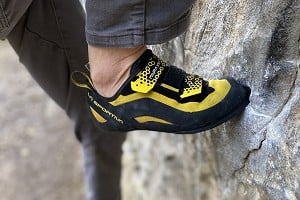
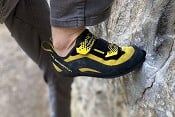
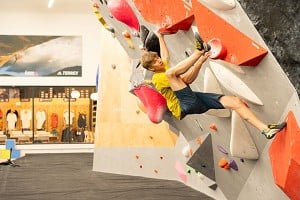



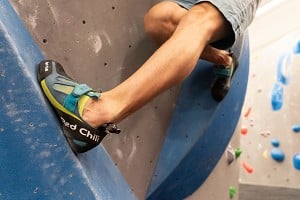
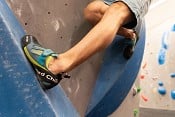
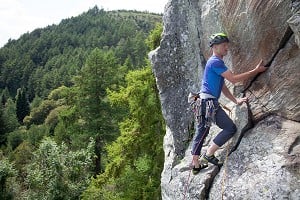
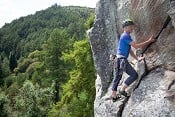


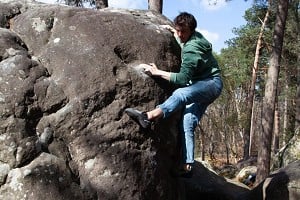
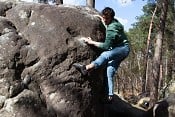
Comments
undoubtedly great shoes, even if the tenaya heel is never quite the right fit for me.
But, if I can go full curmudgeon for a second....
it is really sad to see climbing becoming ever more elitist and unobtainable.
It used to be that bouldering felt attainable for most, especially when MadRock first came to the uk and their prices were so far below the other manufacturers. I do hope that some other upstart company will attempt to flood the market with cheaper shoes again soon, whilst obviously I don't want it done using poor/horrific work practices.
...rant over....
I must admit, I was quite shocked when I saw the price, but sadly - I think it's a sign of things to come. The price of everything have gone up and climbing shoes are no exception, with the cost of the raw materials, labour and shipping all having sky-rocketed in recent times. Whilst I have no doubt that cheap(er) shoes will still be available, I think you can expect the baseline to shift up quite substantially over the next couple of years.
I'm not posting this because I like it, because I don't, but sadly this is something I am hearing repeatedly from each and every brand :-(
£134.50 at Bananafingers. Still pricey but not £160...
I did spot that, but it's a tricky one from our perspective, because the price that a product is sold for is something that is constantly changing. As a result of this, we tend to judge its value according to its RRP, because that is - at least in theory - a little more stable.
If you can find it for cheaper then obviously that's great!
For reference solutions were £100 when they came out in 2008 which is about £160 in 2022 money so the price of high end shoes is only really moving with inflation (solutions at £100 was a bigger shock then as that was about 25% more than other high end shoes)